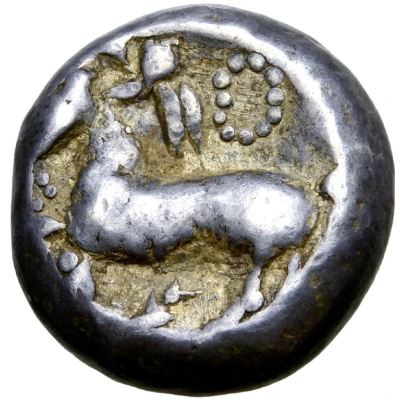


© Roma Numismatics Limited
Tetradrachm Zangenlorbeer Type 300 BC - 201 BC
| Silver | 12.47 g | 19 mm |
| Issuer | Uncertain Eastern European Celts (Uncertain Central and Eastern European Celts) |
|---|---|
| Type | Standard circulation coin |
| Years | 300 BC - 201 BC |
| Value | Tetradrachm (4) |
| Currency | Drachm |
| Composition | Silver |
| Weight | 12.47 g |
| Diameter | 19 mm |
| Shape | Round (irregular) |
| Technique | Hammered |
| Orientation | Variable alignment ↺ |
| Demonetized | Yes |
| Updated | 2024-10-10 |
| Numista | N#193194 |
|---|---|
| Rarity index | 100% |
Reverse
Stylised rider on horseback to left; small wheel circle before, larger wheel circle behind.
Comment
Examples of this type:• Example #1 (12.47g, 19mm, 4h, Extremely Fine) - in main image:
◦ Ex-Hermann Lanz Collection; published in Michaela Kostial - "Kelten im Osten. Gold und Silber der Kelten in Mittel und Osteuropa, Sammlung Lanz", München, 1997, #445;
◦ Exhibited by the Staatlichen Münzsammlung München at the 1997 International Numismatic Congress in Berlin; at the Berliner Bank also in 1997; also exhibited at the Luitpoldblock Palmengarten, Munich in 2003 (exhibition #86[obverse]).
◦ Auctioned by Roma Numismatics Ltd, Auction XVII, 28 March 2019, Lot 119. Sold for 1,900 GBP.
Interesting fact
One interesting fact about the Tetradrachm (Zangenlorbeer Type) coin is that it features a unique design element known as a "zangenlorbeer," which is a type of crescent-shaped ornament that is found on the coins of several ancient Celtic tribes in Eastern Europe. The zangenlorbeer is believed to have been a symbol of the goddess of fertility and prosperity, and its inclusion on the coin may have been intended to convey the tribe's connection to the natural world and their belief in the importance of fertility and prosperity.



